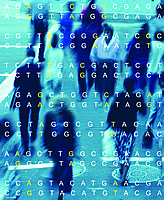Last updated: April 30, 2012
Population genomics: Answering questions from the microscopic to the geographic
Genome Advance of the Month
Population genomics: Answering questions from the microscopic to the geographic
Jonathan Max Gitlin
Science Policy Analyst

The final Genome Advance of the Month for 2011 is actually a twofer, highlighting how population genomics can be used to answer questions in the diverse fields of vascular biology and anthropology. First up, from a multinational team of researchers lead by Dr. Christian Gieger in Germany, and Professor Willem Ouwehand and Dr. Nicole Soranzo in the United Kingdom, is a paper published in the journal Nature. The study takes advantage of genome-wide association study (GWAS) data previously collected in the course of other studies to uncover new genetic pathways that regulate how our bodies make platelets (the second most common blood cell after red blood cells).
Dr. Gieger and his colleagues began by using data gathered in 23 studies (from 48,666 participants of European descent) that had looked for genomic associations related to the number of platelets found in a patient's blood (their platelet count). They also looked at a smaller subset of studies (13 cohorts, 18,600 participants) that included mean platelet volume as well as platelet count. This approach identified 68 areas (loci) of the human genome that were associated with platelet size and number, of which 52 had not previously been linked.
The team followed up this meta-analysis by examining the functions of these genomic loci in fruit flies and zebrafish, two model organisms widely used in genomics. This revealed a number of genes already known to be involved in blood cell regulation and formation, as well as 11 novel genes. Mutations in some of these genes had previously been implicated in Mendelian (rare) diseases and human cancers.
The second study, published in December in the Proceedings of the National Academy of Sciences, moves from the microscopic to the geographic. Using mitochondrial genomes, Dr. Brendan O'Fallon at the University of Washington, and Dr Lars Fehren-Schmitz of the University of Göttingen in Germany, examined the impact of the arrival of Europeans on indigenous Americans. Mitochondrial DNA is passed on from mother to child unchanged, unlike the rest of our DNA, of which we inherit half from each parent. Scientists can therefore use mitochondrial DNA (or haplogroups) to trace back maternal lines through history.
Archeological evidence and historical records from the 16th century paint a picture of a significant reduction in the indigenous population of the Americas as a result of the arrival of Europeans, a result of warfare, enslavement, but particularly through the introduction of diseases for which there was no existing immunity. By contrast, genetic studies that tried to look at the impact of Europe's arrival in the new world had largely been unable to confirm this.
In this study, Drs. O'Fallon and Fehren-Schmitz compared 137 current mitochondrial haplogroups (representing the current ethnic makeup of North America) with 63 ancient samples from sites in Ontario, Canada; Illinois; and Palpa, Peru, dated from 800-2900 years ago. Analyzing the data showed that roughly 500 years ago, the female population of indigenous Americans (since mitochondrial DNA only tells you about the matrilineal line) decreased by approximately 50 percent, a date that coincides with the arrival of Europeans, providing the genomic evidence to confirm the historical record.
Taken together, this pair of studies demonstrates the impact that genomics, and ever-faster, ever-cheaper DNA sequencing, is making throughout the ivory tower, in disciplines as disparate as anthropology and vascular biology.
Read the studies:
Gieger, C., Radhakrishnan, A., Cvejic, A., Tang, W., Porcu, E., Pistis, G., Serbanovic-Canic, J., et al. New gene functions in megakaryopoiesis and platelet formation. Nature, 480(7376), 201-208. 2011. [PubMed]
O'Fallon, B. D., & Fehren-Schmitz, L. Native Americans experienced a strong population bottleneck coincident with European contact. Proceedings of the National Academy of Sciences, 108(51), 20444-20448. 2011. [PubMed]
